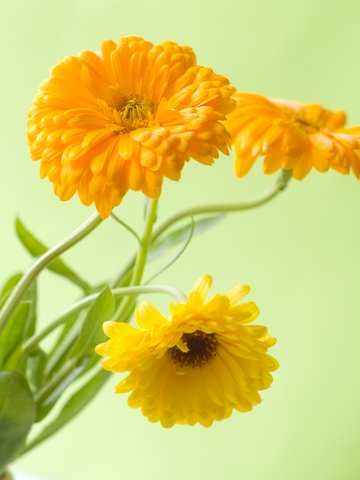So why am I writing about Calendula? For crying out load it’s only December. The reason is pretty simple, I look forward to spring about this time of year and writing about springtime stuff makes it feel close. Hope it does the same for you.
Calendula is one of those herbs really handy to have around the house. It is also a beautiful flower to grow in the garden or in containers off your deck. It’s easy to grow and thrives almost everywhere covering growing zones 3 – 10. Even if you have a black thumb and kill every plant you ever tried to grow, you can grow calendula.
How to grow Calendula
Calendula, often referred to as pot marigold, isn’t a marigold at all. It’s actually a member of the aster/sunflower, daisy, and chrysanthemum family.
To begin with, you will need to buy some seeds of Calendula officinalis. After the last frost, sprinkle them where you want them and cover with ¼ inch of soil. They will bloom in about 30 days. Your little beauties will grow as high 3’ and up to 4” wide with flowers that range from 2” – 4.” If you leave some of the flowers, they will reseed themselves to give you a new crop every year.
Though they like rich soil and full sun, they will grow just fine in partial shade and in most soils, an attribute most commonly given to weeds. They are said to slow blooming in extremely hot climates making spring and fall the ideal blooming times for these areas. In temperate climates, just give them enough water and they will give you flowers from spring until frost.
So there you are with a nice patch of Calendula flowers adorning your yard or deck. Now what? You harvest the flowers during the day. They close up at night and on cloudy days.
Once harvested you have two options. You can use them fresh or dry them for later use.
To dry the flowers, place them on a cookie sheet lined with paper towels. Turn on the oven light and put the flowers in the oven until they dry.
Uses for Calendula
- Rashes including diaper rash
- Use as a baby oil
- Soothes dry skin
- Wounds and bruises
- Sunburn
- Acne
- Athletes foot
- Insect bites
- Insect repellant
To read more on the uses and studies that substantiate claims, go to http://www.herbs2000.com/herbs/herbs_calendula.htm
1. Create Calendula oil
Make the oil by placing 3 to 4 cups of fresh flowers in a jar, cover flowers with olive oil (make sure all flowers are covered), cover jar and allow to steep in dark cabinet for about 3 weeks. After steeping, strain out flowers and you’re done.
2. Create Calendula salve
For every cup of oil created in “Create calendula oil” above, add ¼ cup (2 ounces) beeswax. Warm mixture on low heat just until the beeswax is melted. Pour salve into sterilized jars and cover.
2. Create Calendula tea
Calendula tea is used for sore throats, sore mouth, ulcers and colitis. Simply pour 1 cup of boiling water over 2 teaspoons dried Calendula petals. Steep for 15 minutes, add honey or sugar if you desire and drink. This tea may be gargled or used as a mouthwash when treating a sore mouth or gums. Unsweetened tea can also be used as a rinse for blonde and brunette hair to bring out the highlights.
In addition to the oil, salve and tea mentioned above, Calendula flowers can be used to make potpourri, creams, lotions, perfumes (essential oil) and soaps. The flowers can even be added to salads or used as a natural colorant.
What do I have to say about Calendula? Wow!! Mama Nature knew what she was doing when she created this little gem of a plant. There are only two words of warning associated with Calendula: One, some folks are allergic to Calendula and two, if you are pregnant or nursing, you shouldn’t use Calendula internally.
Now go have fun and relax.
Related articles:

